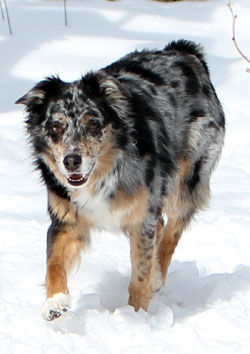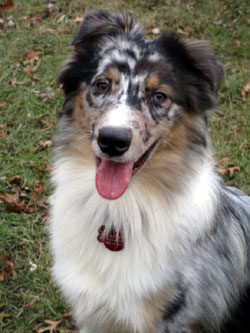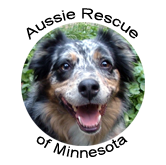The Australian Shepherd – “Aussie”
Australian Shepherds, also know as Aussies, are a medium sized, active herding dog. They generally weigh between 35 and 70 pounds, with most Aussies being between 45 and 55 pounds. Aussies were developed in America to herd livestock on the open ranges of the West. They have the energy and intelligence to herd cows all day and to outsmart the most stubborn of range cattle.

Australian Shepherd
Aussies At A Glance
Energy level: high
Exercise requirements: very high
Playfulness: very high
Affection level: high
Good with children: medium high
Friendliness toward dogs: medium high
Friendliness toward other pets: medium high
Friendliness toward strangers: medium low
Ease of training: very high
Watchdog ability: very high
Protection ability: medium high
Grooming requirements: medium
Heat tolerance: medium
Cold tolerance: medium high
Temperament

Aussies are smart, energetic dogs…
Aussies are smart, energetic dogs who can be as stubborn as and smarter than the toughest of range stock. They are generally high energy dogs and need some kind of activity in which to focus their energy. All Aussies have herding instinct to some degree.
The dogs from working lines have more herding instinct and energy and can be harder to keep as pets. Some dogs from working lines may not be suitable for homes with small children due to the dog’s intense desire to control moving objects. This is one of the chief reasons that an Aussie should never be allowed to run free without close supervision – almost all will chase cars and/or livestock due to this herding instinct.
Aussies cannot be trained not to herd, but their energy can be redirected into other activities.
Aussies were bred to work with people, and so are easy to train with positive reinforcement methods. In order to outrun a stubborn cow or sheep, they were bred for speed and agility in turning. These attributes make them superb agility and flyball dogs. The can accelerate quickly, turn on a dime, and generally jump like they have springs in their feet. Aussies also excel at sports like Frisbee.
The chief problem with teaching an Aussie that chasing a ball is what he should do with his energy is that you will soon feel that you have thrown the ball at least a thousand times each week and that “If I had a nickel for every time I threw this tennis ball, I’d be a millionaire several times over by now.”
Aussies make good watchdogs due to their alertness, but poor protection dogs due to their size. Care must be taken not to encourage an Aussie in barking or they will decide that that is what you want them to do with their energy.
Aussies left alone for long periods of time or as yard dogs often develop destructive habits such as a chewing, barking, or digging.
Coat and Colors
Aussies come in four colors: blue merle, red merle, black tri, and red tri. The merles have a mottled appearance with white and gray appearing in their coat. The blue merles have some black patches and a gray to powder blue appearance, in the non-black areas of their coat while the red merles have a reddish to orange cast and generally brown instead of black patches.
The black and red tris have solid body colors of either black or red.
All four colors can have varying amounts of white and copper trim. The white can cover all four feet, can be in a full circle around a dog’s neck and down to their chest, and can extend up their face in a blaze. White should not be located past the point of the shoulders and should not cover the ears of the dog. The copper trim is located on the feet and on the head.
A tri means a dog that has a solid body color, white, and copper.
A bi is a dog with only a solid body color and either white or copper, but not both.
Two merles should not be bred to one another because homozygous merles can result. These dogs are almost always deaf, have eye abnormalities which commonly cause blindness, and can have internal organ problems with heart problems being them most common. Homozygous merles can be identified by having white that extends past the shoulder blades and covers the head and eyes.
Aussies are a double-coated breed. They have an outer layer of long, somewhat harsh hair and an inner layer (referred to as undercoat) of dense, fine hair. The hair is generally longest on the hind legs and around the chest. The undercoat sheds out twice a year in an event known as coat blowing. During those times, brushing is advised to be done outdoors.
Aussies shed somewhat during the year but a weekly brushing will keep the hair down to a manageable level.
Weekly brushing is required anyway in order to keep mats from forming, especially in the long hair on the legs and behind the ears.
For more information regarding coat color: Inheritance of Color in Australian Shepherd Dogs
Humorous But True
What do Aussies like to herd?
Any living (or non-living) thing that moves faster than a snail, ie; cows, sheep, kids, cats, cars, bikes, vacuum cleaners, lawnmowers, etc.
Why Do They Do This?
Instinct. But basically to make sure their owner are made aware of these moving objects (in case they didn’t know and/or cared), with the objective of rounding them up into one area so they can keep an eye on them. Some Aussies possess less herding instinct than others do, but for the most part they all do it in some form or fashion.
Can they be taught not to herd? No…. but their ‘herding’ energy can be redirected into constructive activities such as playing ball, frisbee, agility, obedience, flyball, etc. Although, after an Aussie has been convinced that chasing a ball or frisbee is what he should be doing with his energy, he will remind you of this every day and you will soon be convinced that if you had a nickel for every time you threw it you’d be a millionaire many times over.
Do They Shed Much?
At the annual ritual known as “blowing coat” you can comb enough fur out of your dog to have spun into enough yarn to make yourself a cap, a scarf and a pair of mittens. Why you would want to is beyond me, since everything else you own is already lavishly decorated with Aussie hair. Since shedding, to some degree, takes place 365 days a year, you will have ample decoration on your rug, couch, bed, etc.
What About Barking?
What about it? If begun early, you can train yourself to come every time your Aussie barks and give it some attention. Give him enough attention for barking, and your neighbors will also begin to give you some attention. Mutual reinforcement always works. What do Aussies bark at? Only things they can see and hear – that includes low flying satellites and butterflies. Most Aussies eavesdrop on a family argument four houses away, yet become selectively deaf upon hearing words like “stop that”, “come here” and “be quiet”. Aussie owners exchange information on stopping barking the way our grandmothers exchanges recipes for pickles – no two were ever alike.
How Do Aussies And Children Get Along?
If you train your children early enough not to tease the dog, wake him by jumping on top of him, pinch his ears or steal his food – your Aussie will be safe from the kids.

